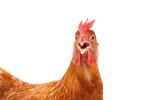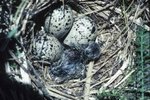
An egg is formed on a journey that will take 25 to 26 hours to complete. It starts inside the chicken with ovulation. A yolk is released from the ovary and travels through the hen's reproductive system as various substances, converted from the hen's food by other organs and systems in her body, build up around the yolk to create an egg.
The Yolk
The left ovary of a newly hatched female chick will contain about 4000 tiny ova or reproductive cells. When the hen matures, some of the ova -- a few at a time -- will develop into yolks. In chickens the right ovary stops developing after hatching.
Each yolk or ovum, while in the ovary, is held in a thin-walled sac or follicle laced with blood vessels that bring nutrients to the yolk to help it develop. When it matures, the yolk breaks free and, enclosed in a vitelline membrane, enters the second part of the chicken's reproductive system, the oviduct.
Fertilized or Unfertilized
The oviduct is a coiled tube about 25 to 27 inches long with glands that secrete the various substances that form an egg. The yolk, after being released from the ovary, is held in the funnel at the entrance of the oviduct, where it is fertilized if the hen is with a rooster and live sperm are present. After 15 minutes, the fertilized or unfertilized yolk continues moving through the oviduct.
Albumen
The next section of the oviduct is the magnum where the albumen -- the egg white, made up of mainly protein and water -- forms around the yolk. This takes about 3 hours to complete. At each end of the yolk, two fine strands of albumen, called the chalazae, are created. They help to keep the yolk in the center of the egg.
Membranes
In the isthmus, the third section of the oviduct, two membranes form around the egg white. They create a base for the shell to stick to and help keep the egg's shape while the shell forms. After 1.5 hours the egg continues on its journey to complete the longest stage.
The Shell
It will take around 20 hours for the shell, made up mainly of calcium carbonate, to form around the egg in the uterus or shell gland, the fourth section of the oviduct. The egg turns in the gland as the shell forms so it is smooth and egg-shaped. Pigment is is added to colored eggs at this stage.
The Egg
When the shell is complete, the egg is coated with a shiny bloom so it passes easily through the vagina and cloaca. It also helps protect the egg, as waste and eggs are expelled from the chicken's vent. However, the intestinal area closes off when an egg is about to be laid to prevent contamination from intestinal waste.
After a journey of 25 to 26 hours, the egg's formation inside the chicken is finally complete. If the hen lays an egg every day -- and this will depend on the time of year and the breed and age of the chicken -- the process will start over again in about 30 minutes.
References
- Chickscope: From Egg to Chick: Formation and Parts of the Egg
- Virginia Cooperative Extension: Poultry Beginning of Life lesson 1 The Egg
- Oregon State University Department of Animal Sciences: Poultry
- The Right Way To Keep Chickens; Shirt, Virginia
Photo Credits
-
Steve Baccon/Digital Vision/Getty Images



